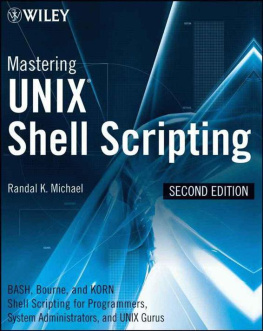Table of Contents

Mastering UNIX Shell Scripting: Bash, Bourne, and Korn Shell Scripting for Programmers, System Administrators, and UNIX Gurus, Second Edition Published by Wiley Publishing, Inc. 10475 Crosspoint Boulevard Indianapolis, IN 46256 www.wiley.com Copyright 2008 by Randal K. Michael Published by Wiley Publishing, Inc., Indianapolis, Indiana Published simultaneously in Canada ISBN: 978-0-470-18301-4 No part of this publication may be reproduced, stored in a retrieval system or transmitted in any form or by any means, electronic, mechanical, photocopying, recording, scanning or otherwise, except as permitted under Sections 107 or 108 of the 1976 United States Copyright Act, without either the prior written permission of the Publisher, or authorization through payment of the appropriate per-copy fee to the Copyright Clearance Center, 222 Rosewood Drive, Danvers, MA 01923, (978) 750-8400, fax (978) 646-8600. Requests to the Publisher for permission should be addressed to the Legal Department, Wiley Publishing, Inc., 10475 Crosspoint Blvd., Indianapolis, IN 46256, (317) 572-3447, fax (317) 572-4355, or online at http://www.wiley.com/go/permissions. Limit of Liability/Disclaimer of Warranty: The publisher and the author make no representations or warranties with respect to the accuracy or completeness of the contents of this work and specifically disclaim all warranties, including without limitation warranties of fitness for a particular purpose. No warranty may be created or extended by sales or promotional materials.
The advice and strategies contained herein may not be suitable for every situation. This work is sold with the understanding that the publisher is not engaged in rendering legal, accounting, or other professional services. If professional assistance is required, the services of a competent professional person should be sought. Neither the publisher nor the author shall be liable for damages arising herefrom. The fact that an organization or Website is referred to in this work as a citation and/or a potential source of further information does not mean that the author or the publisher endorses the information the organization or Website may provide or recommendations it may make. Further, readers should be aware that Internet Websites listed in this work may have changed or disappeared between when this work was written and when it is read.
For general information on our other products and services or to obtain technical support, please contact our Customer Care Department within the U.S. at (800) 762-2974, outside the U.S. at (317) 572-3993 or fax (317) 572-4002. Library of Congress Cataloging-in-Publication Data is available from publisher. Trademarks: Wiley, the Wiley logo, and related trade dress are trademarks or registered trademarks of John Wiley & Sons, Inc. and/or its affiliates, in the United States and other countries, and may not be used without written permission.
UNIX is a registered trademark of The Open Group. All other trademarks are the property of their respective owners. Wiley Publishing, Inc., is not associated with any product or vendor mentioned in this book. Wiley also publishes its books in a variety of electronic formats. Some content that appears in print may not be available in electronic books. This book is dedicated to my wife Robin, the girls, Andrea and Ana, and the grandchildren, Gavin, Jocelyn, and Juliamy true inspiration.
About the Author Randal K. Michael is a UNIX Systems Administrator working as a contract consultant. He teaches UNIX shell scripting in corporate settings, where he writes shell scripts to address a variety of complex problems and tasks, ranging from monitoring systems to replicating large databases. He has more than 30 years of experience in the industry and 15 years of experience as a UNIX Systems Administrator, working on AIX, HP-UX, Linux, OpenBSD, and Solaris. Credits Executive Editor Carol Long Development Editor John Sleeva Technical Editor John Kennedy Production Editor Dassi Zeidel Copy Editor Kim Cofer Editorial Manager Mary Beth Wakefield Production Manager Tim Tate Vice President and Executive Group Publisher Richard Swadley Vice President and Executive Publisher Joseph B. Wikert Project Coordinator, Cover Lynsey Stanford Proofreader Candace English Indexer Robert Swanson Acknowledgments The information that I gathered together in this book is the result of working with some of the most talented UNIX professionals on the topic.
I have enjoyed every minute of my association with these UNIX gurus and it has been my pleasure to have the opportunity to gain so much knowledge from the pros. I want to thank every one of these people for asking and answering questions over the past 20 years. If my brother Jim had not kept telling me, you should write a book, after querying me for UNIX details on almost a weekly basis, I doubt the first edition of this book would have ever been written. I especially want to thank Jack Renfro at Chrysler Corporation for giving me my first shell scripting project so long ago. I had to start with the man pages, but that is how I learned to dig deep to get the answer. Since then I have been on a mission to automate, through shell scripting, support tasks on every system I come in contact with.
I certainly value the years I was able to work with Jack. I must also thank the talented people at Wiley Publishing. As executive editor, Carol Long helped keep things going smoothly. Development editor John Sleeva kept me on schedule and made the edits that make my writing flow with ease. Dassi Zeidel, my production editor, helped with the final edits and prepared the book for layout. John Kennedy, my technical editor, kept me honest, gave me some tips, and ensured the code did not have any errors.
It has been a valuable experience for me to work with such a fine group of professionals at Wiley Publishing. I also want to thank my agent, Carole McClendon, at Waterside Productions for all her support on this project. Carole is the best agent that anyone could ever ask for. She is a true professional with the highest ethics. Of course, my family had a lot to do with my success on this and every project. I want to thank Mom, Pop, Gene, Jim, Marcia, Rusty, Mallory, Anica, and Chad.
I want to thank my beautiful bride forever, Robin, for her understanding, patience, and support for the long hours required to complete this project. The girls, Andrea and Ana, always keep a smile on my face, and Steve is always on my mind. The grandchildren, Gavin, Jocelyn, and Julia, are an inspiration for long life, play time, learning, and adventure. I am truly living the dream. I could not have written this book without the support of all these people and the many others that remain unnamed. It has been an honor! Introduction In UNIX there are many ways to accomplish the same task.
Given a problem to solve, we may be able to get to a solution in any number of ways. Of course, some techniques will be more efficient, use fewer system resources, and may or may not give the user feedback on what is going on or give more accurate details and more precision to the result. In this book we are going to step through every detail of creating shell scripts to solve real-world UNIX problems and tasks. The shell scripts range from using a pseudo-random number generator to creating passwords using arrays to replicating data with rsync to working with record files. The scope of solutions is broad and detailed. The details required to write a good shell script include commenting each step for future reference.
Other details include combining many commands together into a single command statement when desirable, separating commands on several lines of code when readability and understanding the concept may be diminished, and making a script readable and easy to maintain through the life cycle. We will see the benefits of variables and files to store data, show methods to strip out unneeded data from command output, and format data for a particular purpose. Additionally, we are going to show how to write and use functions in our shell scripts and demonstrate the benefits of functions over a shell script written without functions. This book is intended for any flavor of UNIX, but it emphasizes the AIX, HP-UX, Linux, OpenBSD, and Solaris operating systems. Almost every script in the book is also included on the book's companion web site (www.wiley.com/go/michael2e). Many of the shell scripts are rewritten for various UNIX flavors, when it is necessary.
Next page







